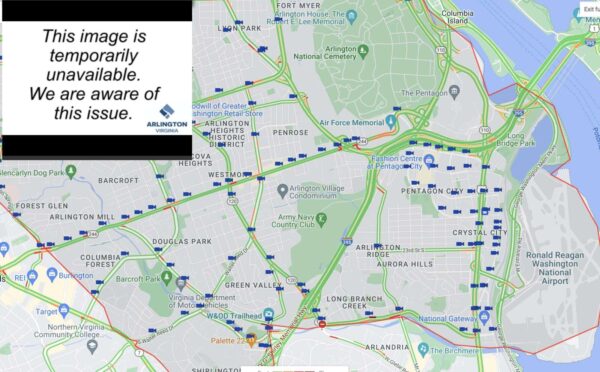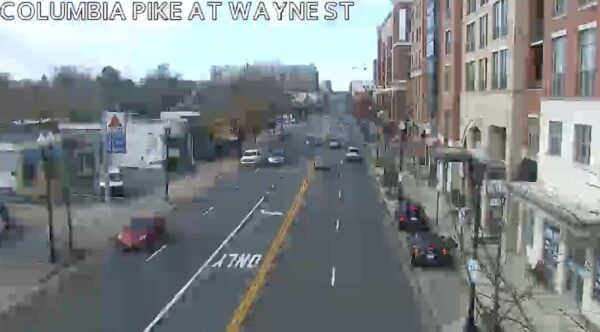
Arlington maintains a sizable network of traffic cameras, but a significant portion of those cameras have been “temporarily unavailable” in recent weeks.
It’s a problem that the county county is promising to fix.
The publicly viewable feeds of conditions on Arlington’s main roads help with real-time reporting on breaking news of crashes or hazardous driving conditions, such as heavy snow. The feeds also allow residents to check conditions before heading out.
Arlington County has more than 200 traffic cameras trained on its roads. As of last weekend, at least two dozen were out. A few weeks ago, in Pentagon City and Crystal City alone, about 40% of cameras were out, according to public safety watcher Dave Statter.
For comparison, it looks like only about 10% of the traffic cameras @VaDOTNOVA has along the entre length of I-395 in Virginia aren't working. That seems a lot more reasonable. https://t.co/RpSD8MWQ4G
— Dave Statter (@STATter911) October 21, 2022
Residents noted outages were an issue when the county moved the feeds from Trafficland.com to an in-house website back in 2015.
The outages have a variety of explanations, but the county is working on addressing them, according to the Dept. of Environmental Services.
“A camera feed can stop working for several reasons like equipment failure, communications issues, or planned construction,” spokesman Peter Golkin said. “Sometimes only a camera’s public feed is impacted while the internal feed continues. Although a single camera supplies both feeds, they can be independently impacted — especially in older analog cameras.”
Thanks for responding. Would also be interested in knowing what rules/guidance the County has issued on the operation of the cameras.
— Dave Statter (@STATter911) October 24, 2022
Public feeds are produced by the DES Transportation Engineering & Operations (TE&O) Bureau. Feeds are also shared internally with the county’s emergency services agencies.
He said while TE&O’s first priority is maintaining the internal feeds that support critical county services, given limited staff and resources, the bureau is “still stepping up its checks of the public feeds.”
“Many public feeds have been restored in recent weeks,” Golkin said. “To avoid confusion, staff are looking at ways to differentiate long-term, planned outages from temporary outages on the public website.”
The outages compound another issue: the county’s policy of censoring public feeds during incidents — from minor crashes to major public safety incidents. Turning off the feeds makes real-time reporting more difficult for ARLnow and other news outelts.
@ReadyArlington If you could rotate the traffic camera there that would be appreciated
— Arlington Now (@ARLnowDOTcom) October 21, 2022
Arlington says it controls what is relayed via traffic cameras during certain incidents to protect privacy.
“Arlington County upholds its values of transparency with public safety information beyond camera footage, including daily crime reports, press releases, emergency alerts, and EMS/fire event summaries,” the county said in a statement. “Camera access furthers our transparency but must be balanced with community privacy concerns.”
ARLnow was provided the following criteria that go into evaluating when to stop publicly broadcasting a traffic scene.
Cameras are diverted to protect:
- Health information: This includes identifiers related to a potential patient, like their face, demographics, and health condition. This is all protected information until the person is determined to no longer be a patient, which occurs after they sign a refusal to be assessed or transported.
- Law enforcement tactics and officer identity: The County protects the identities of law enforcement personnel who serve in plain clothes or undercover roles. Cameras may also be diverted during an active incident, such as an Emergency Response Team (ERT) response, to safeguard tactical information and ensure the safety of all present.
- Victim and witness privacy: Victim and witness privacy protection is always central, but especially if there are juveniles present — something responders wouldn’t know for sure until arriving at a scene. The County also seeks to protect victim and family privacy and dignity by diverting footage in a medical incident, especially when next of kin must be notified of a significant event.
It’s unclear how much identifiable information can be obtained, however, given the relatively lower resolution of the feeds.

While U.S. law clearly protects a right to privacy in the home, privacy in the public arena is murkier, especially as surveillance technology proliferates. Courts have ruled for news outlets in civil lawsuits where someone’s photograph, taken on a public street, was used to illustrate articles without their permission.
Statter says this kind of policy makes government agents “censors [and] editors,” and compounds on the transparency issues caused by outages.
Never good when government agents are the censors & editors. @ArlingtonVA won't even articulate a clear policy. Ridiculous that cameras meant for traffic can't even be used for that. Then there's the horrible way they've maintained this investment of our hard earned money. https://t.co/YvhSMTl7Il
— Dave Statter (@STATter911) October 21, 2022
The Arlington County Board “uses our money to build a system they don’t effectively maintain. Then they restrict it from being used for its intended purpose,” he said, calling on the county to spend “less time censoring [and] more time fixing.”
Some of the the funding set aside for replacing traffic cameras throughout the county is included in the 2022 bond referenda, which voters are asked to vote on today (Tuesday). It also covers any ITS devices like beacons, detection equipment and cabinets, Golkin said.
“We appreciate your continued partnership and the valuable information you share with the community,” the county said in response to the Twitter discussion with ARLnow and Statter regarding traffic camera policies. “Thank you for sharing your concerns and your dialogue about our work.”
Statter said he appreciates the county’s willingness to engage, but pushed for more flexible policies.
“How about re-addressing this issue with a policy that doesn’t waste this resource, isn’t reacting to a possible problem by overreaching [and] doesn’t leave the impression of censorship [and] a lack of transparency?” he said.
This article was made possible by members of the ARLnow Press Club. Join today for the daily Early Morning Notes email.

